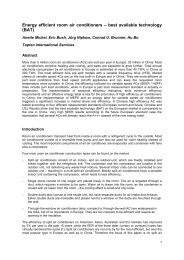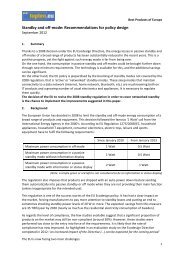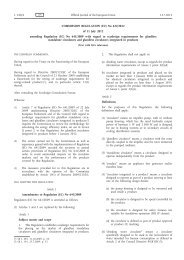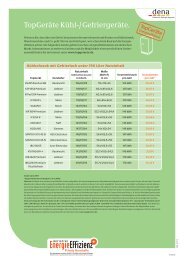EUROPEAN COMMISSION Brussels, XXX […](2012 ... - topten.eu
EUROPEAN COMMISSION Brussels, XXX […](2012 ... - topten.eu
EUROPEAN COMMISSION Brussels, XXX […](2012 ... - topten.eu
Create successful ePaper yourself
Turn your PDF publications into a flip-book with our unique Google optimized e-Paper software.
trigger is not considered a technical justification for the exemption from the<br />
requirements set out in 2(d) in the case of equipment that is not defined as networked<br />
equipment by the manufacturer."<br />
(8) Annex III is replaced by the following:<br />
"Verification procedure<br />
Regarding the requirements set out in Annex II, point 2(d) Member State authorities<br />
shall use the applicable procedure above to measure the power consumption after the<br />
power management function, or similar function, has switched the equipment into the<br />
applicable mode or condition.<br />
Regarding the requirements set out in Annex II, points 3(c) and 4(a) Member States<br />
authorities shall use the applicable procedure above, after having deactivated and/or<br />
disconnected, as applicable, all network ports of the unit.<br />
When performing the market surveillance checks referred to in Article 3(2) of<br />
Directive 2009/125/EC, the authorities of the Member States shall apply the<br />
following verification procedure for the requirements set out in Annex II, points 3<br />
and 4, as applicable.<br />
Member States authorities shall test one single unit as follows:<br />
If the equipment has, as indicated in the technical documentation, one type of<br />
network port and if several ports of that type are available, one of these ports is<br />
randomly chosen and that port is connected to the appropriate network complying<br />
with the maximum specification of the port. In case of multiple wireless ports of the<br />
same type, the other wireless ports shall be deactivated if possible. If only one port is<br />
available, that port is connected to the appropriate network complying with the<br />
maximum specification of the port.<br />
The unit is put in the on mode. Once the proper working of the unit in the on mode is<br />
established, the unit is allowed to go into the condition providing networked standby<br />
and the power consumption is measured. Then the appropriate trigger is provided to<br />
the equipment through the network port and it is checked whether the equipment is<br />
reactivated.<br />
If the equipment has, as indicated in the technical documentation, more than one type<br />
of network port, for each type of network port one port is randomly chosen and that<br />
port is connected to the appropriate network complying with the maximum<br />
specification of the port. If for a certain type of network port only one port is<br />
available, that port is connected to the appropriate network complying with the<br />
maximum specification of the port. Wireless ports not used shall be deactivated if<br />
possible.<br />
For each type of network port the following procedure is repeated. The unit is put in<br />
the on mode. Once the proper working of the unit in the on mode is established, the<br />
unit is allowed to go into the condition providing networked standby and the power<br />
consumption is measured. Then the appropriate trigger is provided to the equipment<br />
through the network port and it is checked whether the equipment is reactivated.<br />
The model shall be considered to comply with this Regulation if the results for each<br />
type of network port do not exceed the limit value by more than 10 %.<br />
EN 10 EN










